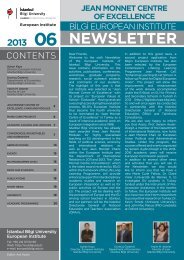WP2 Turkey: Country Report - İstanbul Bilgi Üniversitesi | AB Enstitüsü
WP2 Turkey: Country Report - İstanbul Bilgi Üniversitesi | AB Enstitüsü
WP2 Turkey: Country Report - İstanbul Bilgi Üniversitesi | AB Enstitüsü
Create successful ePaper yourself
Turn your PDF publications into a flip-book with our unique Google optimized e-Paper software.
Social Impact of Emigration and Rural-Urban Migration in Central and Eastern Europe<br />
VT/2010/001<br />
attractive for the Turkish contractual labour in the previous decade. For instance, as of 2008,<br />
the number of Turkish-origin workers in Russia was 130,437 (Ryazantsev, 2009: 160).<br />
Emigration patterns vary in accordance with the social-economic and political changes in<br />
<strong>Turkey</strong>: a) cultural and ethno-cultural motivations; b) ideological motivations; and c) skilloriented<br />
motivation. As explained above, most of the Turkish emigrants left the country on a<br />
temporary or permanent basis due to social-economic reasons. Accordingly, there are quite<br />
a number of people who left the country for various other reasons. Armenians, Greeks,<br />
Assyrians, Ezidis and some other groups, who are mostly non-Muslims, left the country in<br />
different waves when there were nationalist hate crimes directed against them. After the<br />
1960s military coup, the leading members of some tariqats (Muslims sects) left the country.<br />
Similarly after the 1980 military coup, thousands of left-wing politically motivated intellectuals,<br />
activists, Alevis, Kurds, Circassians, etc. left <strong>Turkey</strong>. And finally, the last group of emigrants<br />
who left <strong>Turkey</strong> in the last couple of decades are those qualified people, mostly students,<br />
going abroad for post-graduate studies. Most of them have been going to countries like the<br />
USA, Canada, the UK and Australia (Akçapar, 2009; İçduygu, 2009).<br />
Recently, a significant issue among Euro-Turks is the increasing number of spouses brought<br />
to Europe from <strong>Turkey</strong>. Such partners are known as “imported brides and bride-grooms”.<br />
Such arranged marriages are usually preferred by conservative families, who believe that<br />
brides from the homeland are culturally “pure” and thus capable of raising “better-educated”<br />
children (Akçapar, 2007; Straßburger, 2004). Apparently, this is the new emigration trend<br />
from <strong>Turkey</strong>. However, there is no available data on this matter.<br />
Emigrants nowadays are very different from the way they were in the earlier years of<br />
emigration. In the 1960s, mainly manual labour left <strong>Turkey</strong>. In the 1970s, family members of<br />
those earlier emigrants joined them through family reunification. As already touched upon,<br />
the 1980 neoliberal military coup changed the profile of the emigrants in the 1980s, and<br />
mainly politically-oriented intellectual Kurds, Alevis, and Asyrians left the country. In the<br />
meantime, emigration of skilled people started towards the other countries such as the USA,<br />
Canada and Australia (Kaya and Şahin, 2005; İçduygu, 2009). Emigration of the highly<br />
skilled towards these three countries still continues (Akçapar, 2009; İçduygu, 2009). For<br />
instance, the highly skilled and educated profile of the Turkish community in the USA is<br />
changing in the recent years, as unskilled or semi-skilled Turkish labor workers also arrive in<br />
the country. Regular migration movements were often accompanied by irregular movements.<br />
For example, it is reported that labour migrants reached the USA leaving cargo ships illegally<br />
or overstaying their visa.<br />
There have been around 2.5 million returnees in the early years of emigration between 1961<br />
and 1974, when migration used to have a circular form, which mainly prompted males to<br />
emigrate. Another substantial return took place in 1984 when Germany introduced an<br />
attractive return scheme for those voluntary returnees. The number of returnees in 1984 and<br />
1985 was around 300,000 (Hönekopp, 1990). Return migration in 1987 was around 150,000<br />
but since then has been steadily declining as well (OECD–SOPEMI, various years). There is<br />
recently a new phenomenon, i.e. the return migration of qualified middle and upper middle<br />
class migrants of Turkish origin. It is estimated that around 8,000 Turkish-origin emigrants<br />
and mostly their children come to <strong>Turkey</strong> each year in order to be employed in international<br />
companies like Mercedes, Siemens and Bosch as well as in touristic resorts or international<br />
Call Centres. 8 İnanç Kutluer, the Director of the Netherlands Migration Institute and himself a<br />
Euro-Turk, states that each year approximately 1,000 young Dutch-Turks attracted by the<br />
dynamic Turkish economy migrate to <strong>Turkey</strong> to be employed in international companies<br />
(personal interview, Utrecht, 28 March 2007). According to EUROSTAT, outmigration of<br />
Turkish citizens from Germany exceeded immigration of Turkish citizens to Germany since<br />
8 There are recently several dissertations scrutinizing this newly emerging phenomenon. See Ehrsam<br />
(2011), Kaiser (2003), Bal et al. (2006), and Südas (2010).<br />
Final <strong>Country</strong> <strong>Report</strong> <strong>Turkey</strong> 6



